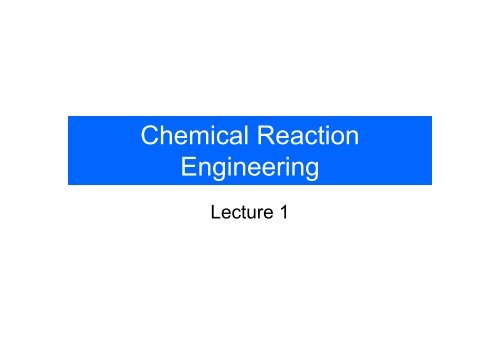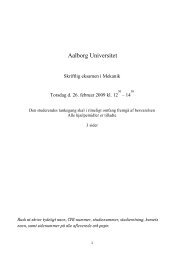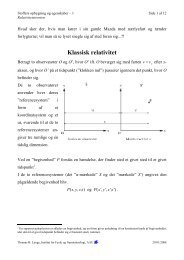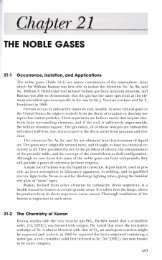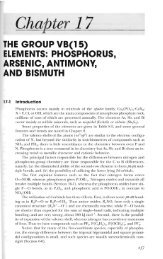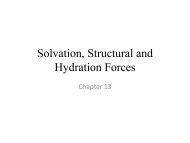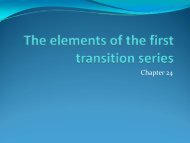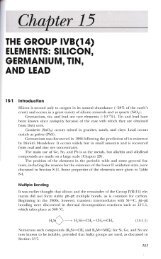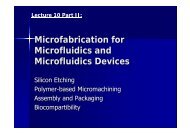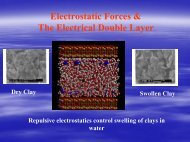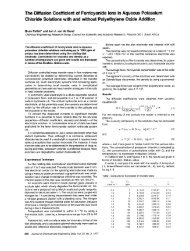Mole balance and design equations for batch and continuous mode ...
Mole balance and design equations for batch and continuous mode ...
Mole balance and design equations for batch and continuous mode ...
Create successful ePaper yourself
Turn your PDF publications into a flip-book with our unique Google optimized e-Paper software.
General algorithm of Chemical Reaction Engineering• <strong>Mole</strong> <strong>balance</strong>• Rate laws• Stoichiometry• Energy <strong>balance</strong>• Combine <strong>and</strong> Solve
Rates of chemical reactionsA + 2B⎯⎯→ 3C+D• Usually we interested in the concentration of one particular reagent, say A.• The reaction rate in terms of reagent A is the number of moles of Areacting per unit time, per unit volume (mol·m -3·s -1 )In the case of heterogeneous reaction the rate will be defined perunit area of catalyst as mol/m 2·s or per unit mass of catalystmol/kg·s− r = d[ A]/dtAOk <strong>for</strong> closed well stirredsystem but,this definition is inconvenient <strong>and</strong> can be misleading because• the concentration of A is varying with time <strong>and</strong> position insidethe reactor,• <strong>for</strong> a <strong>continuous</strong> reactor in steady state, the concentration ata given point is constant in time
The general mole <strong>balance</strong> equation• Generally, the rate of reaction varies frompoint to point in the reactor:GiV= ∫rdVi• The general mole <strong>balance</strong> equation:Fj0− Fj + ∫ rdVi=VdNdtj• From here, <strong>design</strong> equation <strong>for</strong> differenttypes of the reactors can be developed
Types of Chemical Reactors• Depending on loading/unloading of the reactorBatchSemi-BatchContinuosFlowCSTR (Continuous-Stirred Tank Reactor)Tubular reactorPacked-bed reactor
Batch reactors• <strong>for</strong> small-scale operation;• testing new processes• manufacturing expensiveproducts• processes difficult to convert to<strong>continuous</strong> operation
Batch reactorsFj0− Fj + ∫ rdVi=VdNdtjV∫rdVi=dNdtj0• assuming perfect mixing, reaction rate the same through the volumedNdtj=rV• integrating the equation we can get N j vs t –“mole-time trajectory”jt1=∫NNA0A1dNA−rVAtime to reachconcentration N A1 in thereactor can be found
Batch reactorsPfaudler’s Batch reactor
Continuous Flow Reactors• CSTR (Continuous-Stirred Tank Reactor)InOutPfaudler’s CSTR reactor
Continuous Flow Reactors• CSTR (Continuous-Stirred Tank Reactor)Fj0− Fj + ∫ rdVi=VdNdtjF j0F j=0, operation in a steady <strong>mode</strong>• assuming perfect mixing, so• Reaction rate is the same through the volume• Conditions of exit stream are the same as in the reactorF − F =−rVj0j jV =Fj0−−rjFDesign equation of CSTRjorV =vC0 A0−r− vCAA
Continuous Flow Reactors• Tubular reactor• usually operates in steady state• primarly used <strong>for</strong> gas reactions• easy to maintain, no moving parts• produce highest yield• temperature could be difficult to control, hot spots might occur
Continuous Flow Reactors• Tubular reactor– Reaction <strong>continuous</strong>ly progresses along the length of the reactor, so theconcentration <strong>and</strong> consequently the reaction rate varies in axial direaction– in the <strong>mode</strong>l of Plug Flow Reactor (PFR) the velocity is considered uni<strong>for</strong>m <strong>and</strong>there are no variation of concentration (<strong>and</strong> reaction rate) in the radialdirection– If it cannot be neglected we have a <strong>mode</strong>l of Laminar Flow Reactor.
Continuous Flow Reactors• PFR (plug flow reactor) – useful approximation of a tubular reactorV∫F − F + rdV =j0j idNdtj• For every slice of volume:F| +Δ− F|Fj0 − Fj + riΔ V = 0 ri=ΔVj V V jVNo accumulationri=dFdVj0• From here, a volume required to produce given molar flow rate of productcan be determined
Continuos Flow Reactors• Design equation <strong>for</strong> PFRrj=dFdVjdV=dFrjjj j= ∫ =Fj0• If we know a profile of molar flow rate vs. Volume we can calculate therequired volume to produce given molar flow rate at the outlet.VFdFrj∫FFjj0dF−rjj
Continuous Flow Reactors• Packed-Bed reactor – here the reaction takes placeon the surface of catalyst• reaction rate defined per unitarea (or mass) of catalyst( mol A reacted ) /s ( g catalyst )− r′A= ⋅
Continuous Flow ReactorsW – catalyst weight coordinate• as in the PFR case, we can calculate <strong>design</strong> equation now interms of catalyst weight coordinateFFAW |FAW | Wr′| +Δ− F|−+Δ+AΔ W = 0 r′ A=ΔWAW W AWr′ =AdFdWA
Reactors <strong>Mole</strong> Balance: Summary
How we can use <strong>design</strong> <strong>equations</strong>: Example 1-1• ProblemAn isomerization reaction A->B (first order reaction, k=0.23 min -1 ) is run ina tubular reactor with a constant volumetric flow rate v 0 = 10 l/min.Derive <strong>design</strong> equation, sketch concentration profile <strong>and</strong> determine thereactor volume required to achive 10% of A at the exit.• SolutionFrom the mole <strong>balance</strong> <strong>for</strong> PFR:Reaction rate law:− r = kCAs the volumetric flow is kept constant:AAdFAAdV = rdFdVA=v0dCdVAv0dCA1Combining with the rate law:AdV =−kCAVCv0 dCA100dmk C=− = ∫CA0A3
Sizing of reactorsHere we’ll find how to find the size of a reactorif the relation between the reaction rate <strong>and</strong>conversion factor is known
Conversion in the reactorsaA + bB ⎯⎯→ cC + dD• if we are interested in species A we can define thereactant A as the basis of calculation• conversion:b c dA+ B⎯⎯→ C+Da a aXA=<strong>Mole</strong>s of A reacted<strong>Mole</strong>s of A fed• maximum conversion <strong>for</strong> reversible reactions is theequilibrium conversion X e .
Batch reactor <strong>design</strong> <strong>equations</strong>[ ] [ N ]<strong>Mole</strong>s of A reacted =A0⋅ XA[ ] [ ] [ ]<strong>Mole</strong>s of A in reactor, NA = NA0 − NA0⋅XAdNA− = ( −rA) VdtdNAdX=−NA0dt dtNAdX0= ( −rA)VdtDesign equation <strong>for</strong> Batch Reactor• the equation can be integrated to find the time necessary toachieve required conversion• the longer reactants spend in the chamber the higher is thedegree of conversion
Design <strong>equations</strong> <strong>for</strong> flow reactors[ ][ ]F X =A0[ ][ ]F X =A0Molar flow ratefed to the system[ <strong>Mole</strong>s of A fed][ <strong>Mole</strong>s of A reacted][ time][ <strong>Mole</strong>s of A fed][ F ] −[ F ] ⋅ X = [ F ]A0 A0A• molar flow rate can be expressed asconcentration * volume rate[ ] [ ][ <strong>Mole</strong>s of A reacted][ time]F = F (1 − X) = C v (1 −X)A A0 A0 0Molar flow rate of the consumptionof A in the systemMolar flow rate ofA leaving the system
Design <strong>equations</strong> <strong>for</strong> flow reactors• CSTR:[ ] [ ]F (1 )A= FA0 −XVFA0 −FA FA0⋅X= =−r−r( )A A exit• Because the reactor is perfectly mixed, the exit composition isidentical to the composition inside the reactor
Design <strong>equations</strong> <strong>for</strong> flow reactors• Tubular Flow Reactor (PFR):− r =A−dFdVA[ ] [ ]F (1 )A= FA0 −X− r =AF dXA0dVV=FA0X∫0dX−rA• to integrate we need to know r A depends on the concentration(<strong>and</strong> there<strong>for</strong>e on conversion)
Design <strong>equations</strong> <strong>for</strong> flow reactors• Packed-Bed Reactor: similar derivation, but W instead of V− r′=A−dFdWA[ ] [ ]F (1 )A= FA0 −X− r ′ =AF dXA0dWW=FA0X∫0dX−rA′• from this equation we can find weight of catalyst W required toachieve the conversion X
Accounting <strong>for</strong> the reaction rate law• As we see, to find the volume of the reactor weneed to know the 1/r A dependence on X• Let’s consider a first-order reaction:− r (1 )A= kCA = kCA0 −X1 1 1=−r kC (1 −X)AA0
Levenspiel plot• reactor volume required is always reciprocal inr A <strong>and</strong> proportional to X.PFR:V=FX∫A00dX−r• Levenspiel plot:ACSTR:VFA0⋅ X= − rA
Example (2.2, p.48)• Reaction A→B described by the data below <strong>and</strong> the species Aenter the reactor at a molar flow rate of 0.4 mol/s:• Calculate the volume necessary <strong>for</strong> 80% conversion
Example (2.2, p.48)• Solution:– Based on the table the Levenspiel plot can be constructed– The <strong>design</strong> equation <strong>for</strong> the CSTR:V3Fmol m ⋅ s= X V = 0.4 20 0.8 = 6.4m− s molA( 0r )A1exit3
Example (2.3, p.50)• Calculate based on the same data the volume of PFR:– Again, we construct the Levenspiel plot– The <strong>design</strong> equation <strong>for</strong> the PFR:F0.8A03V = ∫ dX = 2.165m0−rA1
• CSTR in seriesReactors in series–1 st reactorF − F + r V =A0 A1 A1 1A1 A0 A0 101V = F X−rF = F −F X1 A0 1–2 nd reactorF − F + r V =A1 A2 A2 2F = F −F XA2 A0 A0 20A11V = F X −X( )2 A0 1 2−rA2
Mean residence time (Space Time)• space time is defined as:τ =Vv0equal to the mean rresidence time inthe absence of dispersion
Reactor <strong>design</strong> <strong>equations</strong>: Summary
Problems• Class problem:– P1-6b (p.30): Calculate the volume of CSTR <strong>for</strong>the conditions of example 1-1.– P2-7b (p.74)• Home problems:– P2-5b– P2-6a ”Hippopotamus stomack”http://www.engin.umich.edu/~cre/web_mod/hippo/index.htm


